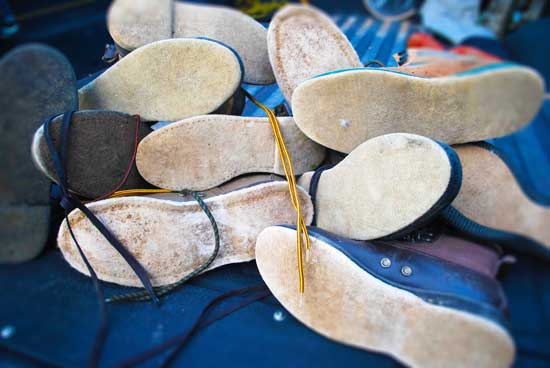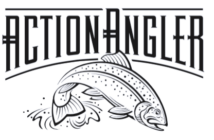Angling Trade has learned that Simms Fishing Products told its sales representatives, and is now informing dealers, that the company plans to reintroduce boots with felt soles in its 2012 product lineup. You may remember that just a couple years ago, Simms was the company that beat the drum loudest about going felt-free, and swore off production of felt-soled boots after 2010.
As most of you know, felt has been associated with the spread of aquatic invasive species… nasty things like New Zealand mud snails, didymo (rock snot), as well as the parasite that causes whirling disease. In some states, the threats have been taken seriously enough that felt is no longer allowed. You can’t fish in felt in Maryland or Vermont, and starting next year, felt will be banned in Alaska.
The science hasn’t changed, but neither did consumers’ and dealers’ attitudes toward wearing felt—there are still many felt stalwarts who contend there is no adequate substitute for traction in a river. And apparently, a good number of dealers claimed they had plenty of customers who could not be sold on felt alternatives.
As such, Simms director of marketing and brand management Diane Bristol said that the company labored over the decision, but ultimately yielded to the demands of customers, specifically dealers, who said they needed felt in the arsenal.
“It’s ultimately about choices, and allowing customers to make their choices on boots with felt,” said Bristol. “We didn’t take this decision lightly, but ultimately it came down to listening to what our customers wanted.”
Which many will assume means it came down to a matter of money… not just for Simms, but also for dealers.
Simms says it is not disengaging from the invasive species fight by any means. Plans are to reintroduce felt on only three boot models, and the company also intends to amp up efforts to inform consumers about the need to wade clean through additional literature and labeling.
Still, Simms will get plenty of flak for the turnaround, and no doubt expects it. But keep in mind that other major boot makers like Orvis, Patagonia, and Korkers, kept right on chugging with felt production in recent years. So don’t expect any stones thrown from glass houses.
Thus, the Simms turnabout is less of a head fake, and more a situation where Simms tried to lead the market across the avenue, then got caught alone in traffic when the lights changed.
Hopefully, the industry as a whole, takes a harder closer look at the felt issue… not necessarily to regulate, rather to amp up efforts to inform the public about the effects of invasive species.
In truth, aquatic nuisances can be transported in many boot materials, not just felt. In some ways, the notion that an angler got a “free pass” from cleaning boots by buying models with rubber soles was as dangerous as it will be to allow responsible choices and encourage responsible care regarding felt.
Now the choices are more open. It will be interesting to see where consumers, retailers, and manufacturers all go with them.





26 Comments
I think Simms and Patagonia and Orvis among others must take this invasives issue to the next level. They need to provide reasonably inexpensive but effective tools for anglers to clean there wading gear.
How about some personal responsibility? A wash basin or a sink, water, scrubbing brush, 409 or hydrogen peroxide, and a little bit of elbow grease do wonders in cleaning felt soles. Don’t forget to add some drying time.
Simms simply got their butts kicked by other brands and realized that they alone do not rule the fly anglers world.
Safety of wading anglers is the first concern and the so called sticky rubber failed in spades.
Education, water and a bit of bleach at the end of the day will go a long way.
Fly tackle dealers across the country knew that this ploy to end felt soles was a bad idea for their customers, we did what we always do….stop buying bad ideas and product.
Ray Schmidt
I agree with you! One point… bleach can wreak havoc on boots. Try hydrogen peroxide as an alternative.
No responsible angler is cavalier about the spread of invasive species with the possible exception of brown trout. But felt soles have been unfairly portrayed as “the culprit”. Neoprene wader feet and gravel guards, woven boot laces, landing net bags, the far greater surface area of wader fabric and lets not forget boat trailers and water craft, may all have broader carrying capacity than felt soles. I invite you to shod one foot in felt and the other in an advanced rubber sole and wade across a rocky river…there would be little debate about traction advantage. As in so many thing in our world, education and appropriate facilities would be more effective than new sole materials. Comfortable benches and cleansing troughs with brushes at popular access points and boat ramps built and maintained by fly fishing industry leaders and national conservation organizations with their names prominently emblazoned on the facilities would allow anglers to cleanse their wading gear while protecting their wading safety with superior footwear. Floaters should also take responsibility to maintain the cleanliness of their rigs. Congratulation to Simms from backing off a black and white stance on this partially understood issue.
I think its common knowledge that your laces and other materials retain water but to compare it to felt soles is a like apples and oranges. Anyone who has fished more than one day in a row knows the last thing to dry on your boots is the felt( not to mention all the sand and dirt they gather). I really expected more from patagonia who is generally a conservation savvy company. And the notion that just because you have rubber soled boots you dont have to clean them is just irresponsible. As dealers we have to do our part to let customers know the risks. And as customers we have to take some accountability for the decisions we make…. just because you pay for a license doesnt mean you have the right to do whatever you want. It doesnt cost you anything to freeze or boil your felt to disinfect
I don’t think it matters if you have felt or rubber soles on your boots when it comes to the spread of invasive species. The sides and tops of my boots are just as dirty/muddy as the soles (if not more) when I pack it in for the day. You have to clean/disinfect the whole boot regardless of what the material the sole is made of.
I am glad they are re introducing felt soles. We are tired of slipping on rocks all over the place, older clients had a hard time wading on the “new tech” sticky rubber (useless). We must teach our clients to rinse their boots with bleach and buy a new pair of boots if they travel, the cost of a pair of felt soled boots has minimal impact on the budget.
God bless felt soles
Ditto’s to Jesse, cp, and Richard. I have not seen any science that indicates that felt alone is the culprit. The Orlando ICAST show had an aftermarket show held at the same time and a company from New York had a product used on boats to kill fungus, mold, bacteria which could be used on boots. I gave the contact information to two different manufacturers as a possibility for cleaning all part of the boots and waders. It is used on hard and soft surfaces that are encountered on a boat. If you are in another country with your boots, shoes, etc. and have walked in livestock areas the USDA will clean your boots/shoes when you go through customs. I am not sure why so many companies make changes in a product line without consulting some of their larger dealers in all parts of the US market? Loss of raw material is sometimes the problem but felt is certainly not in short supply.
Pingback: Felt boots are back. - The North American Fly Fishing Forum
First of all, there is no single chemical decontamination method that will kill all 4 major invasives of Dydimo, Whirling Disease, NZ Mud Snails, and Zebra Mussels that does not damage boots and waders.
Secondly, rubber boot soles at this time do not match felt for grip across multiple river types – this is a safety issue for anglers.
Finally, if the the nooks and crannies in felt are an issue why not eliminate the the stocking foot and separate wading boot and go to a single integrated impermeable boot foot wader system?
Dydimo seems to be the major concern and I have a separate pair of wading boots for the Madison River and another two pairs for the two rivers I fish in my home state. My boots never cross state lines. Isolation of equipment is the surest way to prevent spread.
As a fly shop manager I have sold and tested many boots over the years.
I fished with felt soles to start with but tried Aqua stealth tread when it came out to reasonable success. When Simms converted all of their boots to Stream tread I was a little worried but after doing my own tests on some of the worst waters I was impressed with the new tread.
Felt certainly beat most of the rubber treads on the market but the Simms stream tread was the closest to felt traction I could find. In fact there were some circumstances when it out performed felt. When hiking in wet muddy riverbanks and when fishing in large boulder filled rivers the felt slipped badly. The dechutes river evened the score with no sole out performing the others unless they had studs. All in all the Simms sole was better than felt and even stays the same weight after a full days fishing.
I still have felt boots in stock from other vendors but they don’t sell half as well.
I have basically quit using felt myself mainly due to the better grip it gives me and I like the fact that it dries out much faster.
I applaud Simms for their initiative but don’t fault them for bringing back a limited felt sole offering.
Sent from my iPhone
Stephen Woodcock
Pingback: Report: Simms to Re-Start Felt Sole Boot Line | MidCurrent
I agree with the comment that it would be nice if sporting shops and motels, etc, supplied a trough and water supply possibly at their place of business near popular fishing areas. I wouldn’t mind bringing my own bleach and going to a shop to disinfect. Also, we could use some educational guidance on how to clean not just boots, but waders also. I have no clue what to use on my breathable waders and wouldn’t want to harm them by using bleach.
I don’t find this move particularly surprising. In point of fact, felt works better than any sticky rubber soles that I’ve had occasion to test. For Simms and others in this business environmental activism does not trump lost market share. Yes, it’s an embarrassment but most of the angling public will not even notice.
Studded boots are the only way to go. Period. IMHO. Felts get slimmed and are less effective. Sticky Rubber doesn’t cut through slime. All unstudded boots are like riding a unicycle compared to the 4WD safety of studs. In fresh water, I only use studded boots. To me all wading boots should be synthetic bottomed studded boots and let the felts stay in the hobby shops for decorations.
As some have pointed out, the issue is not simply about felt, it is about inspecting, cleaning, and drying your gear. The 80+ page New Zealand study which was the first in depth study on this topic actually shows that leather uppers and interior of the boots carried more aquatic hitch hikers than the felt soles, but after 48 hours the trend started to reverse itself because the felt took longer to dry. Therefore, dry time is a critically important piece of this discussion that many miss.
Korkers new 2011 range of boots not only incorporate hydraphobic, quick-drying materials on the uppers, but also have our patented interchangeable sole system that allows you to use (and care for) your gear in a completely unique way. By interchanging different soles, you can fish multiple different watersheds in consecutive days knowing that you have taken a responsible approach with regard to the sole of your boot. This is virtually impossible to do with a traditional fixed felt sole boot.
Singlebarbed.com had an interesting notion; one that Korkers actually can fulfill. He commented that if a manufacturer (said manufaturer being SIMMS) sold their boots for half the normal price then fisherman could have more then one pair of boots (echoed by silver Creek) for more then one fishing situation. The debate will rage on about felt and laces, and boot materials and seams etc… but most everyone agrees that we fisherman can and do transport critters from water to water. Responsible cleaning of equipment can not be replaced meterial substitues however, having multiple sets of boots can be another step in curbing spreading invasives.
Currently, most quality boots are out of the range of most people in terms of having two, three and four pairs for various water curcumstances. But a couple of pairs of Korkers and a couple extra felt sole replacements could well be within most peoples budget. The sinthetic materials clean and disinfect quickly and a clean dry set of soles can quickly be attached and your off fishing.
More food for thought.
I might not be as educated as I should be regarding this issue, but to my understanding, drying your gear completely is the best method of dealing with invasive species. 409 and/or bleach is effective, but the fisheries people are thinking that exposing your fishing waters to these chemicals might not be the best thing. And if drying works, why risk contaminating the waters and destroying your gear by using chemicals? Perhaps we need to have the correct information available to everyone as a means of combating invasive species, regardless of the method.
Of lesser import is the Simms turnaround. The protection of our watersheds were so important that they were willing to take a stand and halt production of the dreaded felt soled boots. BRAVO for them. O.K., so the cost of boots went up. And the price of studs went up. And we can surmise that the profits went down. And it seems odd that no other issues were addressed by a company that also makes other items that are known to assist in the spread of invasive species (waders, staffs and so on). The obvious conclusion here is that profits ARE the motive for manufacturers to be in business. We all know this. I just hate to be reminded of it. There are more purists in the streams than there are those who sit in the CEO chairs. Most of what you need to know about life you can learn while fishing………
Having worn several brands of wading boots without felt soles I applaud Simms for a u-turn on producing felt bottom boots. Even with metal studs in the rubber bottom boots, they were slippery in the water and dangerous when wading in fast moving water of free-stone streams and rivers. I have had not such problems with felt bottom boots under numerous conditions. I do dry my boots and I do wear boots that are river designated. Having used the felt-less boots is no guarantee not to spread invasive species, for one only needs to look at all the nooks and crannies that exist in and on these boots and realize that they are as capable as felt bottom boots to entrap and carry unwanted vermin.
It is the responsible fisher-person to make sure she/he is not a carrier. CLEAN or DRY your boots before moving from one water to the next.
Scientist in Idaho with the State Dept. of Ag, says that 104 degree water will kill infected flet soles….Go figure…Whats keeping keeping industry from funding a study and declaring the correct application for felt boot owners….
I think it comes down to Simms wanted to reduce their inventory load by having one style of boot soles and not have to keep up with felt and Vibram soles in production/warehousing. When the GIVE FELT THE BOOT campaign gave up a lot of the market share to companies like Korkers, Chota, and other companies who kept felt sole boots, Simms took action to increase sales. I don’t believe Simms had any concern when deciding to bring back felt other than the dollar (as they more or less said when stating consumers and dealers drove them to this decision). I wound up buying a pair of Korkers boots because I could get felt and the studded vibram style sole and switch them out as needed. I’d assume they felt this across the country and saw dollars walking out the door.
I’m all for cleaning stations at access points and a better education campaign for cleaning gear and stopping the spread of water born pathogens. It seems some companies just tried to cram rubber soles down everyone’s throat, but did nothing to educate in the “clean all of your gear” arena.
Pingback: Simms Plans About-Face on Felt | Angling Trade | John Dwyer's Angling Journal
Education is key. Case in point- Catch and release bass fishing. It was unheard of until the early 90’s. Now people are so into it, you can’t hardly take a legal fish home for dinner without getting dirty looks in the parking lot.
Pingback: Motivations for banning felt soles? - Page 3 - The North American Fly Fishing Forum
Pingback: Raise Your Hand if Your State Banned Felt Boots - Page 2 - The North American Fly Fishing Forum